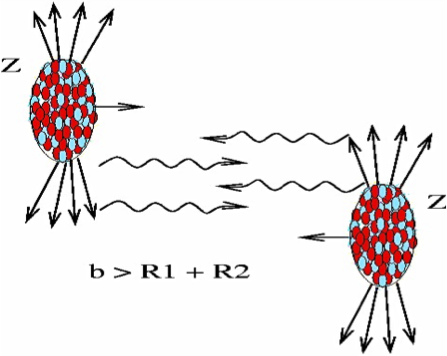Peripheral Collisions
Fast moving highly-charged ions carry strong electromagnetic fields that act as a beam of photons. In collisions at large impact parameters (b>R1+R2), hadronic interactions are not possible, and the ions interact through photon-ion and photon-photon collisions known as ultra-peripheral collisions (UPCs). Ultra-peripheral hadron-hadron collisions will provide unique opportunities for studying electromagnetic processes. Ultra-relativistic heavy-ion interactions have been used to study nuclear photo excitation (e.g., to a Giant Dipole Resonance) and photoproduction of hadrons.

Hadron colliders like the Relativistic Heavy Ion Collider (RHIC), the Tevatron, and the Large Hadron Collider (LHC) produce photonuclear and two-photon interactions at luminosities and energies beyond that accessible elsewhere.
UPC PWG
Updated on Fri, 2013-07-12 13:35. Originally created by wlodek on 2013-07-12 13:35.| Time | Talk | Presenter |
|---|---|---|
| 09:30 | ANN, ASS paper preview ( 00:45 ) 1 file | Dmitry Svirida |
| 10:15 | RP Phase II* ( 00:30 ) 1 file | J.H. Lee |
| 10:45 | Phase II* Planning ( 00:30 ) 1 file | Wlodek Guryn |
| 11:15 | Central Exclusive Production in Run 2009 ( 00:45 ) 1 file | Leszek Adamczyk |
12:00 | Lunch Break ( 01:30 ) | |
| 13:30 | B- Slope update ( 00:30 ) 1 file | Ivan Koralt |
| 14:00 | Rho Update ( 00:30 ) 1 file | Ramiro Debbe |
BUR 13 Discussion
Updated on Tue, 2012-04-17 15:54. Originally created by wlodek on 2012-04-15 13:56.Reference
Speaker : Wlodek Guryn + All ( BNL )
Talk time : 14:30, Duration : 00:45
Geant Simulation of Elastic Trigger Efficiency
Updated on Mon, 2012-04-16 17:19 by koralt. Originally created by wlodek on 2012-04-15 13:52.Reference
Speaker : Ivan Koralt ( ODU )
Talk time : 14:00, Duration : 00:30
Geant simulations of Si response
Updated on Tue, 2012-04-17 11:40 by mariuszp. Originally created by wlodek on 2012-04-15 13:50.Reference
Speaker : Rafal Sikora ( AGH Cracow )
Talk time : 13:30, Duration : 00:30
Ultra Peripheral Collisions
Updated on Mon, 2012-04-09 09:52. Originally created by wlodek on 2012-04-09 09:52.| Time | Talk | Presenter |
|---|---|---|
| 09:00 | Rho diffraction status ( 00:45 ) 0 files | Ramiro Debbe (BNL) |
| 09:45 | J/Psi cross section status ( 00:45 ) 1 file | Dilan Madagadohettige Don (Creighton University) |
| 10:30 | Embedding status ( 00:30 ) 0 files | Ramiro Debbe / Dilan Madagodahettige Don (BNL/ Creighton) |
11:00 | Break ( 00:30 ) | |
| 11:30 | e+e- / phi analyses ( 00:30 ) 0 files | Janet Seger (Creighton) |
| 12:00 | Triggering Plans and Issues ( 00:30 ) 0 files | (Creighton) |
12:30 | Lunch ( 00:00 ) | |
| 14:00 | Central Exclusive Production in pp2pp data from Run 2009 ( 00:45 ) 1 file | Leszel Adamczyk (AGH University of Science and Technology) |
Ultra Peripheral Collisions
Updated on Mon, 2012-04-09 09:51. Originally created by wlodek on 2012-04-09 09:50.| Time | Talk | Presenter |
|---|---|---|
| 13:30 | Geant simulations of Si response ( 00:30 ) 1 file | Rafal Sikora (AGH Cracow) |
| 14:00 | Geant Simulation of Elastic Trigger Efficiency ( 00:30 ) 1 file | Ivan Koralt (ODU) |
| 14:30 | BUR 13 Discussion ( 00:45 ) 1 file | Wlodek Guryn + All (BNL ) |
pp2pp analysis
1-189 Physics, at 14:00 (GMT), duration : 02:00
We will have our weekly meeting Wedensday, July 25, 10 a.m. EST in 1-189 in Physics. Here are the topics
1. Updates: Cracow, ITEP
2. Update from Ivan
Wlodek
Title: pp2pp
Description:
Community: STAR
Password: elasticpp
Meeting Access Information:
- Meeting URL
http://evo.caltech.edu/evoNext/koala.jnlp?meeting=eueneeviveaBaDItaBIu
- Password: elasticpp
- Phone Bridge
ID: 12 5134
Password: 5158
| Time | Talk | Presenter |
|---|---|---|
| 09:00 | Normalization update ( 00:20 ) 1 file | Igor Alekseev (ITEP) |
| 10:20 | ANN & ASS with STAR normalization ( 00:20 ) 1 file | Kin Yip |
| 10:40 | Ivan's update ( 00:20 ) 2 files | Ivan Koralt (ODU) |
pp2pp analysis
1-189 Physics, at 14:00 (GMT), duration : 02:00
pp2pp analysis
1-189 Physics, at 14:00 (GMT), duration : 02:00
pp2pp weekly
1-189 Physics, at 14:00 (GMT), duration : 02:00
| Time | Talk | Presenter |
|---|---|---|
| 10:00 | Study of elastic trigger bias in pp2pp run 2009 ( 00:20 ) 1 file | Rafal Sikora (AGH UST) |
pp2pp analysis
1-189 Physics, at 14:00 (GMT), duration : 02:00
1. Run 13, what to expect - Wlodek
2. Talk rehersal Low-x Janusz
3.Other...
Web link:
http://drupal.star.bnl.gov/STAR/event/2012/06/06/pp2pp-analysis
Wlodek
Title: pp2pp
Description:
Community: STAR
Password: elasticpp
Meeting Access Information:
- Meeting URL
http://evo.caltech.edu/evoNext/koala.jnlp?meeting=eueneeviveaBaDItaBIu
- Password: elasticpp
- Phone Bridge
ID: 12 5134
Password: 5158
pp2pp analysis
1-189 Physics, at 14:00 (GMT), duration : 02:00
pp2pp analysis
1-189 Physics, at 14:00 (GMT), duration : 02:00
